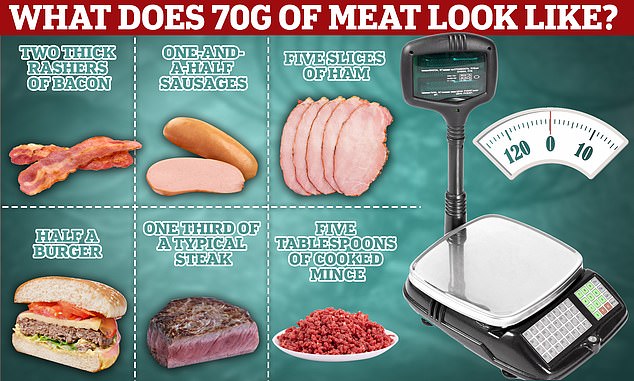Revealed: How much red meat you should limit yourself to each WEEK, according to science (and it’s bad news if you like bacon for breakfast…)
A few sausages and slices of bacon are the main ingredients of a full English breakfast.
But to top it all off for red meat lovers, scientists warned about this today two servings per week may increase your risk of developing type 2 diabetes mellitus.
Researchers from Harvard University, who examined the eating habits and diabetes rates of 200,000 people, advised to stick to one serving per week to ‘optimize health’.
But a typical portion of 70 grams is roughly equivalent to just two thick slices of bacon or one and a half sausages, meaning a cooked breakfast contains around 130 grams.
As it stands, UK health chiefs are advising Britons to eat no more than one 70g portion per day.

A typical portion of 70 grams is roughly equivalent to just two thick slices of bacon or one and a half sausages, meaning a cooked breakfast contains around 130 grams. As it stands, UK health chiefs are advising Britons to eat no more than one 70g portion per day. However, experts behind the new health warning classified a serving of processed red meat as 28-45 grams, while a serving of unprocessed red meat was 85 grams.

The findings suggest that eating just two bacon sandwiches, one hamburger or two-thirds of an 8 oz steak increases the risk of type 2 diabetes.
This amount of meat is also equivalent to five slices of ham, half a beef burger or a third of a typical steak.
Five tablespoons of cooked minced meat, half a lamb steak, one and a half cans of hot dogs or 15 slices of pepperoni or salami also reached the toll of 70 grams.
However, experts behind the new health warning estimate that one serving of processed red meat weighs 28-45 grams, while a serving of unprocessed red meat weighs 85 grams.
Red meat has been demonized for decades because of a wealth of evidence suggesting that eating too much can increase the risk of heart disease, cancer and early death.
Although it is a good source of protein, vitamins and minerals, including iron, zinc and B vitamins, it can be high in salt and saturated fat.
And processed varieties can be packaged with controversial preservatives and chemicals designed to keep it fresher, improve taste and improve appearance.
No specific reasons have been found why red meat can lead to an increased diabetes risk.
But red and processed meat intake has been linked to weight gain, and being overweight or obese are among the highest risk factors for developing the condition.
British health chiefs recommend consuming no more than 70 grams of red meat – such as beef, lamb or pork – or processed meat – such as ham, bacon and salami – per day.
Previous studies have shown a link between red meat consumption and the risk of type 2 diabetes, but the researchers said their study provides more certainty about the link.
Experts examined the health data and diets of 216,695 people who were surveyed about what they ate every two to four years for up to 36 years.
During this time, more than 22,000 participants developed type 2 diabetes.
Results, published in the American Journal of Clinical Nutrition shows this Eating red meat – both processed and unprocessed – was strongly associated with an increased risk of type 2 diabetes.
Those who ate the most red meat – about two and a half servings a day – had a 62 percent higher risk of developing the condition compared to those who ate the least.
And each additional daily serving of processed red meat was associated with a 46 percent greater risk of developing type 2 diabetes.
Each additional daily serving of unprocessed red meat was associated with a 24 percent greater risk, the study found.
However, replacing a portion of red meat with dairy products was associated with a 22 percent lower risk.
Although the study mainly looked at daily servings of meat, the researchers argued that their findings showed a clear risk for anything above two servings per week.
Xiao Gu, lead author and postdoctoral researcher in the department of nutrition, said: ‘Our findings strongly support dietary guidelines that recommend limiting red meat consumption.
‘This applies to both processed and unprocessed red meat.’
Professor Walter Willett, senior author of the study and an expert in epidemiology and nutrition, said: ‘Given our findings and previous work by others, a limit of around one portion of red meat per week would be reasonable for people looking to optimize their health and wellbeing. .’
According to the scientists, swapping red meat for healthy plant-based protein sources would help reduce greenhouse gas emissions, tackle climate change and provide other environmental benefits.
Around 3.9 million Britons have type 2 diabetes, while a further 850,000 people are believed to be living with the condition but have not yet been diagnosed.
In the US, approximately 33 million people have type 2 diabetes.
Research shows that the number of adults with diabetes is expected to more than double by 2050 due to the increase in obesity.
